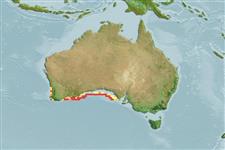Elasmobranchii (sharks and rays) >
Squatiniformes (Angel sharks) >
Squatinidae (Angel sharks)
Etymology: Squatina: Latin, squatina, -ae = a kind of shark (Ref. 45335).
Environment / Climate / Range
Ecology
Marine; bathydemersal; depth range 120 - 400 m (Ref. 41394), usually ? - 300 m (Ref. 6871). Temperate, preferred ?; 30°S - 35°S, 115°E - 136°E (Ref. 54910)
Eastern Indian Ocean: endemic to Australia.
Length at first maturity / Size / Weight / Age
Maturity: Lm ?, range 115 - 125 cm
Max length : 100.0 cm TL male/unsexed; (Ref. 31576); 125.0 cm TL (female)
Found on the continental shelf and upper slope. Common in about 300 m depth (Ref. 6871). Ovoviviparous (Ref. 50449). Flesh is tasty (Ref. 6871).
Life cycle and mating behavior
Maturity | Reproduction | Spawning | Eggs | Fecundity | Larvae
Ovoviviparous, embryos feed solely on yolk (Ref. 50449).
Compagno, L.J.V., 1984. FAO Species Catalogue. Vol. 4. Sharks of the world. An annotated and illustrated catalogue of shark species known to date. Part 1 - Hexanchiformes to Lamniformes. FAO Fish. Synop. 125(4/1):1-249. Rome, FAO. (Ref. 247)
IUCN Red List Status (Ref. 115185)
CITES (Ref. 94142)
Not Evaluated
Threat to humans
Traumatogenic
Human uses
More information
ReferencesAquacultureAquaculture profileStrainsGeneticsAllele frequenciesHeritabilityDiseasesProcessingMass conversion
Tools
Special reports
Download XML
Internet sources
Estimates of some properties based on models
Phylogenetic diversity index (Ref.
82805): PD
50 = 0.5000 [Uniqueness, from 0.5 = low to 2.0 = high].
Bayesian length-weight: a=0.00603 (0.00280 - 0.01298), b=3.04 (2.83 - 3.25), in cm Total Length, based on LWR estimates for this species & (Sub)family-body (Ref.
93245).
Trophic Level (Ref.
69278): 4.5 ±0.62 se; Based on food items.
Resilience (Ref.
69278): Low, minimum population doubling time 4.5 - 14 years (Fec assumed to be <100).
Vulnerability (Ref.
59153): High vulnerability (62 of 100) .
